admin
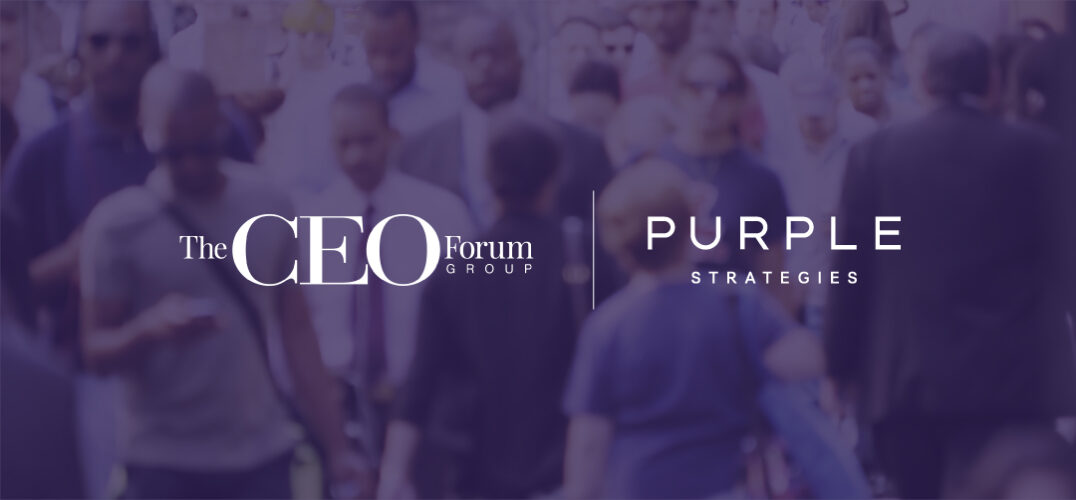
Posted on
June 16, 2022
4 Min. Read
Author
Purple Strategies
CEOs Embrace Expectation to go Beyond Corporate into Societal Leadership
Three Themes from The CEO Forum’s Second Annual Transformative CEO Summit
Purple Strategies is the thought leadership and polling partner of The CEO Forum Group and Transformative CEO Summit. The CEO Forum convened its Second Annual (and fifth quarterly) Transformative CEO Summit on April 21, 2022, featuring many CEOs of leading companies discussing creative ways to solve today’s most pressing challenges.
The story of the first-ever Transformative CEO Summit was about CEOs embracing the pivot from health crisis to human connection as the world emerged from the first year of the pandemic. The thread through discussions among executives at the second annual installment held in April of this year focused on a shift for the CEOs themselves as executives embraced growing expectations from stakeholders that they take on even more of the mantle of societal leadership.
The public expectation for business leaders to play a role in areas outside of their business interests is not new. But the pressure for business leaders to step into broader societal issues appears to be intensifying. Contending with the third year of COVID, along with an economy-shaking war in Europe, continued global supply chain disruptions, and more tipping-point moments at home around issues such as reproductive health, guns, justice and democracy, CEOs find themselves more often in the spotlight and more frequently called on to be a part of the solution to some of the most challenging issues facing society.
The following areas are at the forefront for CEOs as they lean into those growing societal expectations – what the Summit theme articulates as “creating a new world ecosystem” – and what might come next for CEOs.
(1) Leading society through workforce transformation.
Even in the space closest to “home” for executive presence – within the walls of companies – the need for CEO leadership is quickly becoming more expansive. To start, many of those walls are now virtual. Workforce realities have empowered employees to demand more flexibility and sustained hybrid work. How companies treated their workers, and in particular their working parents, became a variable shaping corporate reputation, as internal and external stakeholders watched and evaluated how well corporate America supported its employee base.
Those expectations around flexibility and supporting working parents are just two manifestations of a larger trend CEOs see of employees increasingly driving culture and pushing for clearer corporate purpose. Transformative CEOs aren’t threatened by the activism of their employee base; rather, they are measuring, understanding and harnessing their employees’ purpose and passion and using it to fuel both business success and the company’s ability to have a broader impact on society.
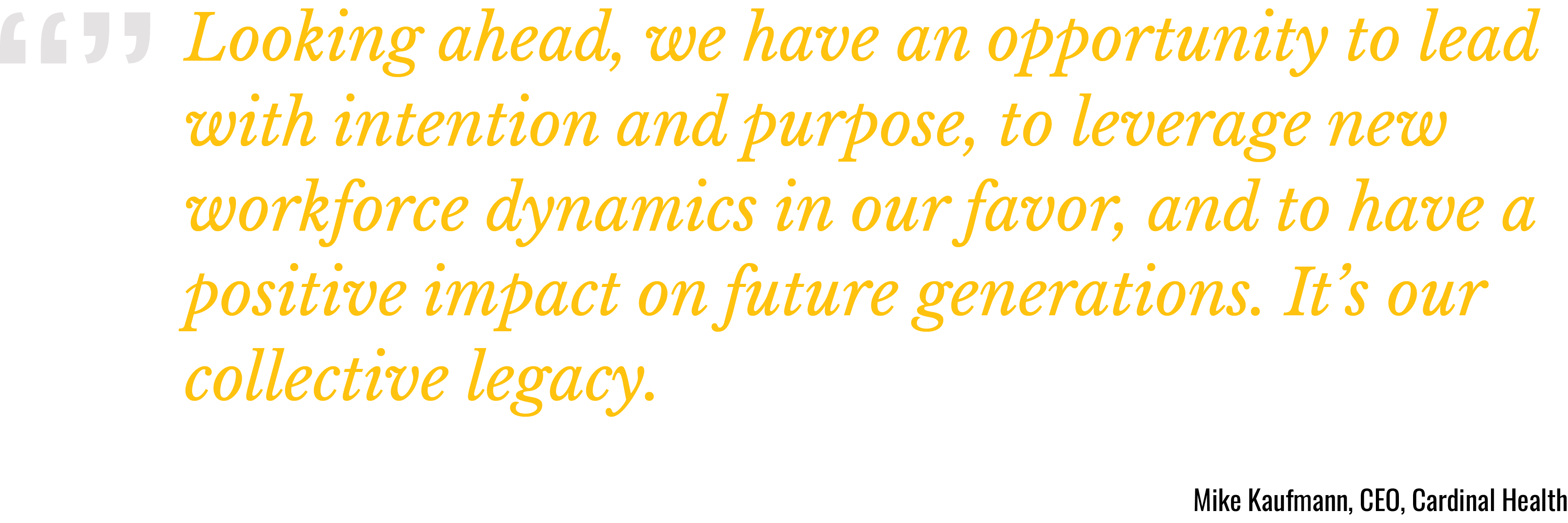
(2) Leading society through interconnected crisis and innovation.
In crisis playbooks of old, CEOs might have been guided through scenarios primarily impacting just the company, its customers, its industry, and the communities in which it operates. The last few years have seen crises become much more expansive, with CEOs being asked to lead in times of crisis through a complicated interconnected web of global health, race, economy and climate, all at once. Transformative CEOs agree that navigating this unprecedented style of crisis demands an unprecedented willingness on their part to flex and to fail. To flex, by throwing out old structures and silos and preconceived notions about what is possible. And to fail, by being open to big new ideas, failing fast and quickly course-correcting – a successful strategy through not only crisis but also innovation.
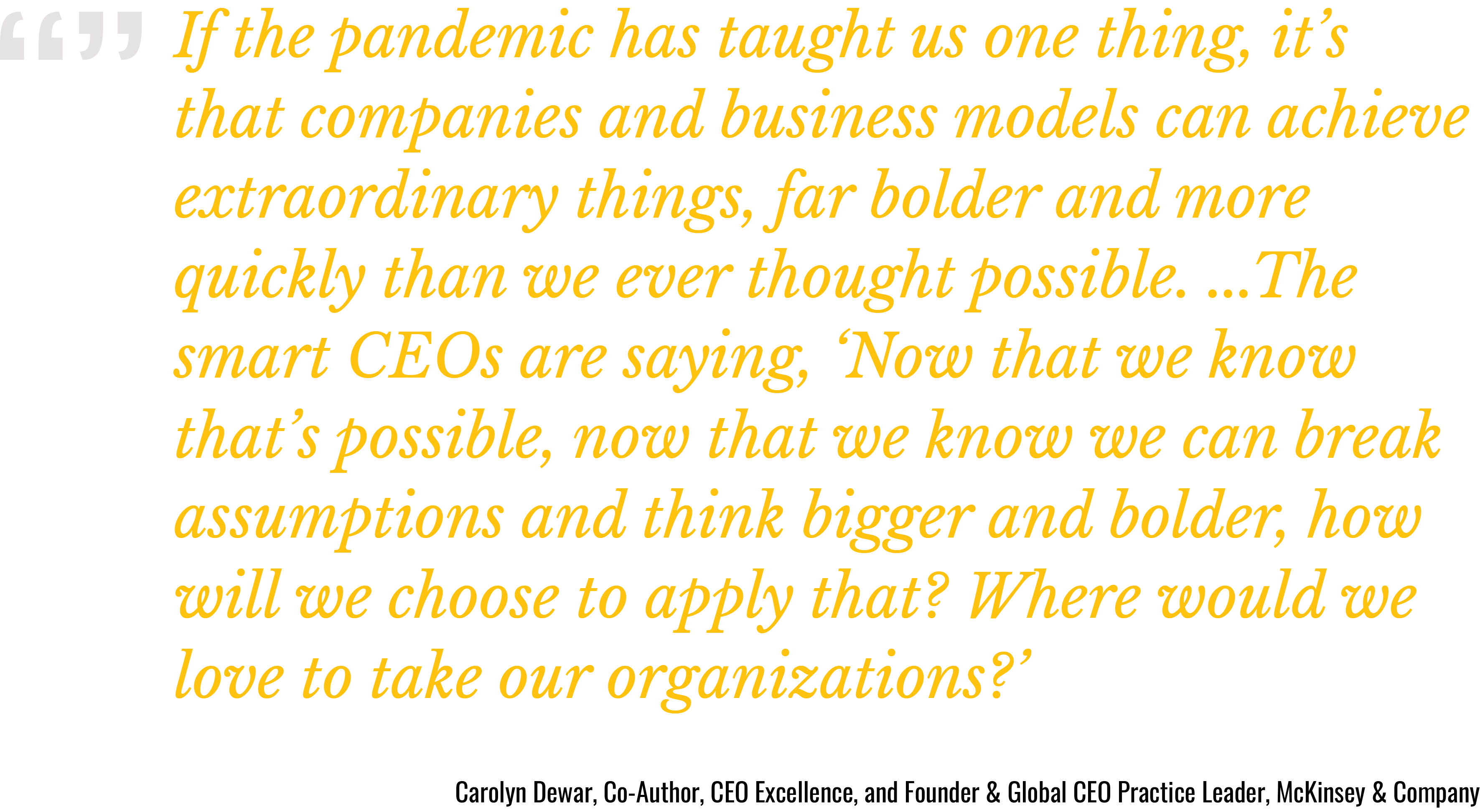
(3) Leading society through social and political issue discourse.
Americans increasingly expect companies to play a role in speaking out on issues impacting the public and society, while at the same time, more and more executives agree they have some responsibility to respond to major societal or geopolitical events. Purple Strategies polling of Transformative CEOs during the Summit revealed 3 in 4 feel prepared to weigh in or respond to societal issues on behalf of their companies. CEOs are also quick to point out that global impact doesn’t require action on a global scale: Authentic investment and commitment in a local community can build to influence the global community. As CEOs evaluate their purpose and responsibilities on these kinds of issues, Summit participants encouraged one another to be intentional about where, when and how they are using their voice – and then backing it up with actions.
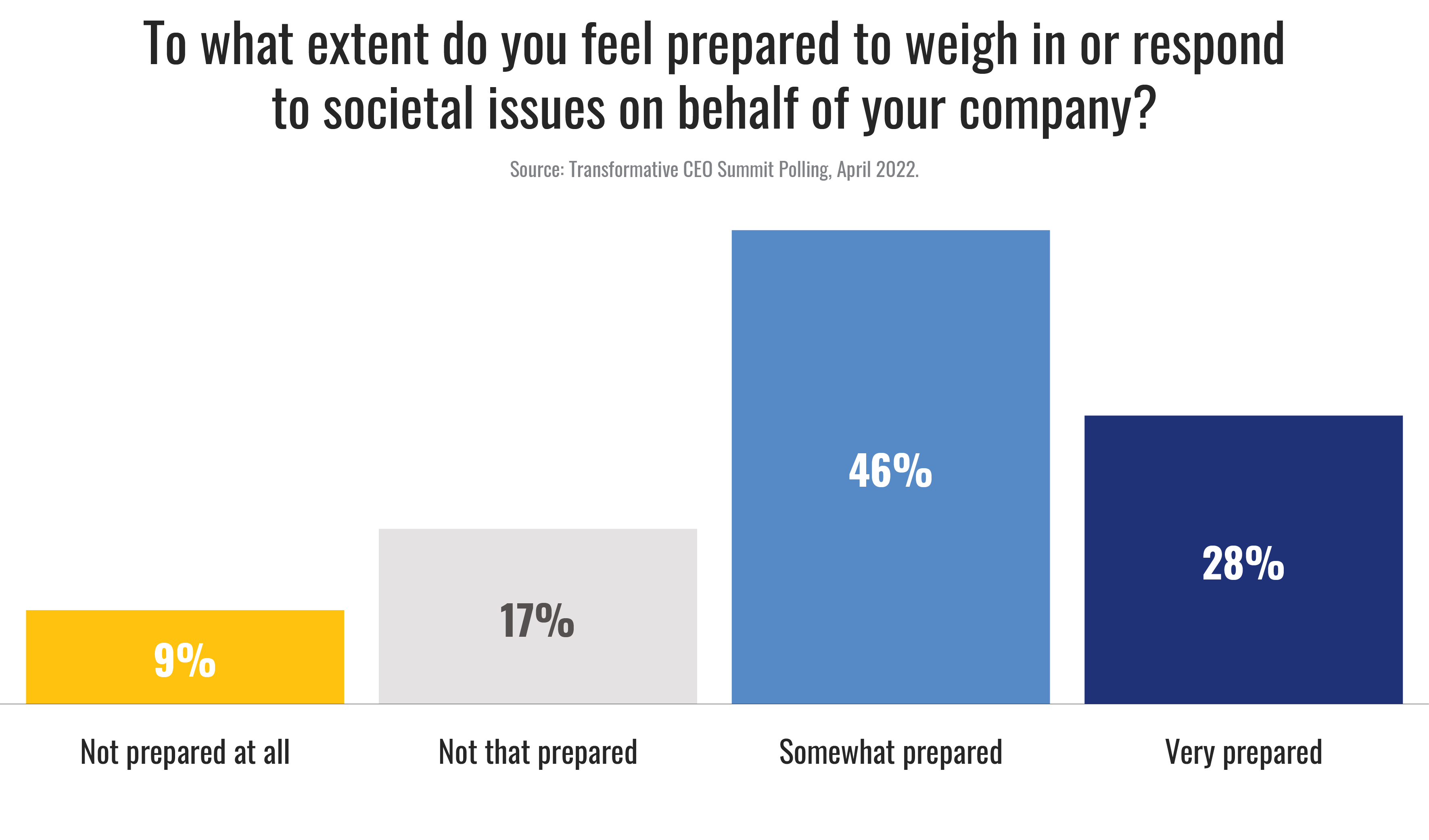
While the growing remit of the CEO looks poised to continue into even more expansive societal leadership expectations, Transformative CEOs are ready for the challenge. Summit participants were united in optimism that CEOs are prepared to meet this moment of new opportunity and engage in shaping the global ecosystem that is evolving before our eyes.

Posted on
May 6, 2022
2 Min. Read
Author
Purple Strategies
Purple Adds Fourth of July Week Off
Since Purple was founded, the firm has closed down operations the last week of each year to celebrate the winter holidays and give its passionate Purple people a chance to unwind and unplug all at once. Now, Purple will be doing it twice.
Starting this summer, the Purple team will celebrate its independence each year with an entire week off for the Fourth of July (July 4-8 in 2022, and July 3-7 in 2023).
Purple Managing Partner Kristen Morgante, on the calendar addition (from LinkedIn):
“Our companywide wind down at the end of the year is something we treasure, so adding another such week – particularly after the weight and pace of the last two years – is something all of us welcome.
“Purple people have always loved spending time with Purple people and being available for each other and their teams. Sometimes, though, that causes them to feel that pull even when they are supposed to be out of the office if the rest of their team is in the office. It’s a tension all of us in a client service organization face if we’re passionate about what we do. And Purple people are that, in spades.
“So we’re working with our team to realize that their client and team focus not only allows for this kind of reset, it requires it.
“When our people are refreshed and recharged, we can see it in the work we do with our clients. The strategy, the solution, the research insight, the creative idea: They are stronger and better when the people behind them are at their best.“We can also feel it in the halls, over video screens, and in the Slack chatter that keeps us laughing.

Posted on
April 8, 2022
3 Min. Read
Author
Purple Strategies
Kristen Morgante Named Purple Strategies Managing Partner
Purple Strategies has elevated Kristen Morgante to be Purple’s first Managing Partner. Having been with the firm since its founding, Kristen has been COO for the past decade and was named a partner in 2015.
“Purple’s business and team have grown exponentially in recent years and increasingly all roads lead to Kristen,” said Steve McMahon, Purple co-founder and CEO. “Just as some of the world’s most significant corporations turn to Purple as a partner for navigating change, Alex and I turn to Kristen as our partner in charting the course for the firm. We are fortunate to have had her alongside us since the beginning and now in this new role for Purple.”
As COO, Kristen has been responsible for all day-to-day operations of the business and leading the firm’s long-term growth strategies. In her role, Kristen aligns Purple’s unique talent and expertise against client needs to deliver high-performing teams. Through her work with the founding partners, she is credited with scaling Purple’s client offering, building its dynamic culture, and creating a rewarding place to work for professionals from a cross a multitude of disciplines.
“Kristen is without question the heart and soul of Purple,” said Alex Castellanos, Purple co-founder and chairman. “This firm continues to be the special place that it is in largest part because of the sharp, talented people who make it their professional home. Kristen has been instrumental in shaping the experience of each person who walks through our doors, and I’m confident I speak for all of them when I say we’re excited Kristen has agreed to take on this role.”
Kristen got her start in Democratic politics, beginning her career in the Clinton Administration, and continuing her work on state and federal Democratic campaigns across the country, including Howard Dean’s Presidential campaign in 2004. Before Purple, Kristen served as Associate for Strategic Planning and Special Assistant to President and CEO John Podesta at the Center for American Progress. Kristen currently serves on the Board of Trustees for the nonprofit policy advocacy group, Stronger Fairer Forward.
“The team at Purple is extraordinarily special. I’m proud of our work in both partnering with clients to tackle their toughest challenges, while also investing in our internal culture and community to make this place a magnet for such brilliant and interesting people,” Kristen said. “The growth and success Purple has enjoyed has put us on an exciting path of transformation as a firm, and I’m grateful for the trust Steve, Alex and our other partners have placed in me to help ensure we continue to scale and evolve in ways that best support our outstanding team and our clients.”
In addition to Kristen and co-founders Steve McMahon and Alex Castellanos, Purple’s partnership includes Chief Creative Officer Jillayne Smyth Rogers, John Gatti, Chris Durlak and Rory Cooper; and founding partners, emeritus, Mark Squier and Robin Roberts.

Posted on
March 23, 2022
4 Min. Read
Author
Keeley Hanlon
Five Pandemic Trends Leaders Should Leave Behind—and One That’s Here to Stay
A VERSION OF THIS ARTICLE FIRST APPEARED IN FAST COMPANY
Over the past year, preeminent CEOs from across the country convened for a series of Transformative CEO Summits, hosted by The CEO Forum Group and supported by Purple Strategies. As the year ended, we reviewed what those CEOs had to say on a range of topics and what year three of the pandemic brings for their companies, workforces and the global economy.
While these discussions uncovered lessons to carry into this third year of pandemic-era leadership, top CEOs also identified trends from the past year worth leaving behind.
LEAVE THESE
Using terms such as “post-pandemic” and “back to normal”
Across industries, business operations have been mired by unpredictability since the COVID-19 pandemic began. More than once, however, it seemed we neared the beginning of the end.
Now with variants raging and record-high COVID-19 cases continuing to make headlines, today’s leaders understand a return to pre-pandemic business is unlikely anytime soon or ever, and many of the challenges wrought by COVID-19 are here to stay.
CEOs have learned to expect the unexpected. They make plans for the months ahead while encouraging their organizations to prepare for every potential scenario.
Establishing a “return to work” timeline
As of March 2022, many corporate employees have spent the past two years working from someplace outside the office, and for most, that set-up won’t change anytime soon.
Top CEOs acknowledge that corralling folks back into the office five days a week might be near impossible. As a result, they are prioritizing flexible solutions that meet the unique needs of their organizations and employees. The majority (66%) of CEO Forum Group leaders we surveyed in July 2021 indicated their companies plan to operate in a hybrid model going forward, acknowledging employees’ desire for continued workplace flexibility.
While remote work has introduced the dreaded “Zoom fatigue” to many people, company leaders and their employees alike have recognized that virtual meetings have their benefits too. Nearly two-thirds of workers reported having more access to their leaders now than before the pandemic, according to Purple Strategies’ polling of the employed Informed Public. As one CEO put it, “There is no hierarchy in a Zoom call. No head of the table. There’s something really empowering about that—it leads to a more innovative culture.”
Believing a public statement on an issue is enough
Leaders and companies have demonstrated their willingness to address some of the country’s most pressing issues head-on. But more and more, they’ve realized that speaking out isn’t enough. Successful companies will differentiate themselves by making substantive commitments and providing transparent updates on their progress.
When it comes to making substantial progress against their DEI and ESG commitments, CEOs agree on the importance of setting concrete and attainable goals around issues like creating an inclusive workforce and advancing climate sustainability. Taking this step forces their companies to follow through on the plans they’ve announced. Driving transformative change goes beyond chasing positive PR—these values and aspirations must be embedded into a company’s DNA.
One CEO shared, “We expose our diversity and inclusion metrics to the world in a public forum; there was collective recognition and actions like that really do help drive change.”
Assuming there’s a choice between automation and technology or people and jobs
The pandemic has only accelerated the adoption of cutting-edge technologies, but conversations around what this transformation means for workers have centered around a false dichotomy between job creation and job losses.
CEOs successfully implementing next-generation solutions know that while automation and technology are critical to advancing the efficiency and convenience that pandemic-era customers have come to expect, people remain essential when it comes to applying creativity, making ethical decisions and operating with humanity. During the Second Transformative CEO Summit, one CEO said, “We need to humanize digital implementation.”
Leaders see a window of opportunity to up-skill their workforces to work with the latest technologies. Last year, 45% of CEOs reported reskilling their employees as a primary focus area when polled during the Second Transformative CEO Summit. By seamlessly implementing automation and new ways of working while preparing workers for higher-paying jobs essential for future success, leaders can create a win-win situation for everyone.
Treating the Great Resignation like a waning, pandemic-driven phenomenon
More than 4.5 million Americans quit their jobs in November 2021, the highest rate in more than two decades. The pandemic made employees feel emboldened to realign their priorities—to focus on family, find more purpose-driven opportunities or pursue a new career path entirely—and employers must be willing to do the same. That means examining pay structures, benefits, set hours and expectations for commuting and in-office work.
Leaders are also seeking to ensure purpose and fulfillment are part of the deal. If the great resignation has taught us anything, it’s that many Americans look for opportunities that provide more than a paycheck.
“The old playbook is gone,” said a CEO in the financial industry. “Leadership requires purpose-driven, future-forward and leader-led transformation.”
KEEP THIS
Maintaining human connection in the workplace remains crucial to success
The one trend of “year two” executives should continue to implement in the third year of the pandemic? Empathetic leadership.
For 44% of the Informed Public, being in a workplace with empathy and human connection is more important now than before the pandemic (with another 40% indicating it has always been important). This new emphasis on empathy is even higher for employees who are 18-34 years old (52% say it is more important now), parents (49%), working in a fully remote or hybrid environment (49% each), or whose volume of work (48%) or level of work-related stress (53%) has gone up during the pandemic.
Empathy is no longer an abstract, new-age idea in executive management; Fortune 500 companies are learning it’s mandatory in their C-Suites.
Why is that? Empathy can be the antidote to each of the challenges outlined above. Recent research from Catalyst found that empathetic leadership can boost productivity, foster creativity, promote feelings of inclusion and reduce intent to seek new employment.
The good news is many leaders agree with the Informed Public. “There is an opportunity to use empathy to think about new ways to connect with people,” one CEO from the banking industry said. “Empathy should make a strong comeback and is the key to building trust. And that’s where the growth is.”
The ability of leaders to practice empathy will be critical not only for the year ahead but for the evolving future of work as we know it.
Throughout 2022, businesses will need to identify and react to a new set of emerging trends and evolving COVID-era mandatories. Leaders from Capitol Hill to Wall Street to Main Street frequently look to corporate America for guidance, so companies can set the tone by leaving recent pandemic-driven trends behind and leading with empathy, creativity and flexibility.
By Keeley Hanlon | Senior Director

Posted on
February 9, 2022
5 Min. Read
Author
Purple Strategies
Teammate Reflections on Black History Month
In honor of Black History Month, Purple’s Diversity, Equity and Inclusion leads invited some of the incredible Black talent across Purple to share reflections about what this month means to them, Black leaders who inspire them, and more. Below, we highlight their perspectives on Black history, culture, traditions, joy and excellence.
With contributions from: Sedale McCall, director of digital insights and one of Purple’s DEI leads; Jasmine Graves, research analyst; Antoine Fagan, designer; Georgia Boothe, accountant; Giselle Tervalon, communications manager; and campaign coordinators Latisha Townsend, Kimberly Chavis, Jaymi Thomas and Chioma Onwumelu.
What Black History Month means to you.
- Georgia: Black History Month is a celebration of our ancestors’ excellence and motivation to always strive for the greatness that lies beyond our current circumstances. It is an important time to celebrate the impact of African American culture in the past and present. It reminds us of hope and opportunity for the future.
- Giselle:
- Jasmine: Black History Month gives us the opportunity to reflect and gain an understanding of the Black experience in America. Black History Month can foster a sense of community both within and outside of the Black community through learning about Black history that is often missed.
- Jaymi: Black History Month is always a time for me to focus on aspects of history that are fascinating, inspiring and packed with nuanced experiences. One of the most enriching moments I had as a college student was crossing the Edmund Pettus Bridge from Selma to Montgomery, Alabama while I was taking a sociology course.t was a reminder to me that in the summer of 2007 when I crossed the bridge, leaders and laypeople alike crossed that bridge less than 50 years prior. Black History Month reminds me to pause, reflect and honor the legacy of those that led and paved the way for freedoms that shouldn’t be taken for granted.
- Kimberly: To me, Black History Month is the time to celebrate and showcase all things Black. To really soak in and appreciate all our achievements, cultures, traditions and customs. It’s also a great time for allies to further educate themselves on just how valuable Black people are and have been throughout American history, past the obvious.
- Latisha: Every month is Black History Month for me! During the month of February, I think it’s a great time to be in communion with Black people all across the African diaspora. There is a certain knowing we all share, and that feeling is unmatched. To me, BHM means accountability, reflection and unity.
- Sedale: Black History Month provides a moment for others to learn about the community and highlight the progress of African Americans in the country. I think that’s something I try to do every month, but I appreciate the moment for others to focus more.
Black History Month traditions.
- Antoine: During Black History Month, I support Black businesses of all kinds: clothing, food, hygiene, self-care and art. There are so many Black business owners, especially small businesses, and entrepreneurs with a great product or service. They deserve both emotional and financial support.
- Chioma: I watch some Black classics and pick a novel from the Well-Read Black Girl Library!
- Giselle:
- Kimberly: I buy from and support Black businesses year-round, but during BHM I really turn it up a notch and try to make sure anything I spend my money on is coming from a Black business. I also like to watch my favorite Black movies and TV shows all month and cook all my favorite childhood foods.
- Latisha: I enjoy watching Black films, reading Black literature and listening to Black podcasts and music. I do this regularly, but I really like the way that our talent gets amplified during BHM.
A Black leader who inspires you.
- Chioma: I’m inspired by Kimberle Crenshaw, civil rights advocate and critical race theory scholar, and President of MSNBC Rashida Jones.
- Georgia: Michelle Obama because she is truly a modern-day, revolutionary woman who has championed a multitude of important causes throughout her life. She is a Harvard graduate, lawyer, best-selling author and the first African American first lady. Michelle Obama is proof our country has indeed evolved.
- Jasmine: Madam CJ Walker has inspired me as a young Black woman really interested in hair care since the age of seven. Many people know her and admire her because she was the first Black millionaire. However, I think her civil rights work, dedication to improving the lives of African Americans through jobs and opportunities, and impacts on the hair care industry are significantly more admirable. She once said, “I am not satisfied in making money for myself. I endeavor to provide employment to hundreds of women of my race.”
- Jaymi: I am inspired by countless Black leaders who have blazed paths and continue to move the needle forward in modern-day civil rights and justice. A couple of the “under 18” leaders captivating me include Naomi Wadler, who at age 11 shifted the atmosphere during a March For Our Lives speech, and Marley Dias, the purpose-driven 16-year-old who founded #1000BlackGirlBooks and author of the book, “Marley Gets It Done.” I am amazed by how these young women shine and share their gifts with the world in brave and innovative ways.
- Kimberly: bell hooks. Her writing has been majorly influential in the empowerment of Black women to tackle love, race and gender inequalities, and more. I think her work is reviving a movement in Black women today.
- Latisha: A Black woman leader who inspires me is Judy A Smith, a crisis management expert. A Black male leader who inspires me is Malcolm X.
- Sedale: I have two for similar reasons, Dr. Ibram X. Kendi and Ta-Nehisi Coates. Both give context to the things many of us believe but don’t always express through words. Many people know Dr. Kendi as the author of “How to Be an Anti-Racist,” but he is also director of the Center for Antiracist Research, which he started at American University (now at Boston). Both are advocates for many things, but chief among them is knowing better so that we can do better. This is my passion in this space as well.
Other reflections to share.
- Antoine: Black is beautiful, creative, fun, loving, persistent and brave. Be proud of your Blackness at all times.
- Jaymi: As someone who is inspired by history and reflective in nature, I am passionate about the work of future Black leaders – those who will be able to say they lived and created hope and light during some of the bleakest moments including a pandemic, heightened loneliness, civil unrest and turbulent political polarization. In a landscape where some states are wrestling with what it means to teach Black history, my hope is that Black History Month serves as a sort of north star in the conversation around the importance of teaching history with breadth and depth.
- Latisha: Cultural competency in the workplace is of high importance. During Black History Month, non-Black colleagues can show support by listening, respectfully engaging in conversation about Black history, and treating BHM and all other Black holidays as commemorations solely of Black people.
- Sedale: I believe Black history is American history. If you are wondering how to celebrate or observe, whether you identify as Black or not, learn about a Black leader you haven’t studied yet, or even learn more about a Black colleague and their experience. When we learn more about other communities, we can be better as a society.

Posted on
January 20, 2022
2 Min. Read
Author
Purple Strategies
Purple Partners with George Mason University Athletes Josh Oduro and D’Shawn Schwartz
Purple Strategies has entered into a name, image and likeness (NIL) deal with two members of the George Mason men’s basketball team, Josh Oduro and D’Shawn Schwartz. They will both serve the company as Transformation Ambassadors, sharing their personal transformation stories.
“Purple Strategies is dedicated to helping companies transform to become their best versions and sustain that transformation in a way that connects them to the future. As student-athletes Josh and D’Shawn have undergone their own personal transformations,” said Chris Durlak, a Partner at Purple Strategies and Trustee of the George Mason University Foundation. “They both created a vision of what they wanted to become and how that vision fits in with the future. They then executed a plan to fulfill that vision – plans that evolve to account for the changing conditions around them. We look forward to sharing their personal stories as we continue to help some of the world’s largest and most valuable companies and brands navigate change and transform.”
Josh Oduro is from Gainesville, Virginia, and is a junior at George Mason University majoring in business. Josh ranks second in the A-10 and 29th nationally in field goal percentage (.596). He is one of just three players in the country this season to average 17 or more points, shoot 58 percent or better from the floor and tally at least 1.5 blocks per game.
“Personal development is a major passion of mine, and I’m excited for the opportunity to work with a leading firm like Purple to share my story,” Josh said.
D’Shawn Schwartz is from Colorado Springs, Colorado, and is a graduate student at George Mason pursuing his certificate in business analytics. Out of high school, he was rated the number one player in the state of Colorado. He received his undergraduate degree from the University of Colorado in business marketing with a minor in music technology. At Colorado, he helped lead the Buffaloes to the second round of the 2021 NCAA tournament. This season, D’Shawn has been named one of 30 candidates for the NCAA Senior CLASS Award, which recognizes student-athletes using their platform in athletics to make a positive impact as leaders in their communities.
“I’m thrilled to be working with Purple Strategies. Having just earned a degree in business, there’s a lot of overlap between athletics and business and I can’t wait to explore and share that,” D’Shawn said.
Josh Oduro Shares his Story
D’Shawn Schwartz Shares his Story
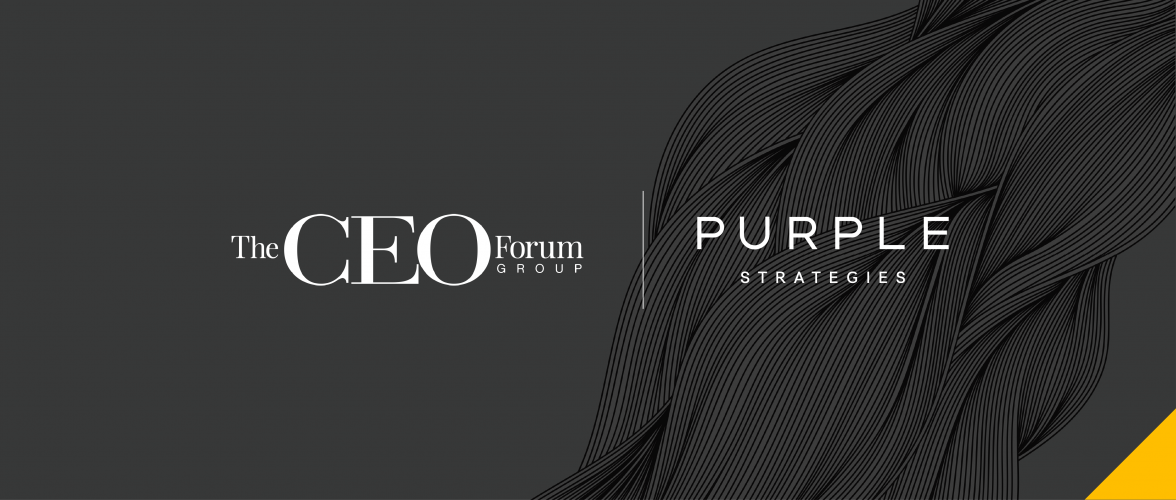
Posted on
December 22, 2021
4 Min. Read
Author
Purple Strategies
CEOs Share Views on ESG Challenges and Opportunities
4 Lessons for Leaders from The CEO Forum’s Third Transformative CEO Summit
Purple Strategies is the thought leadership and polling partner of The CEO Forum Group and Transformative CEO Summit. The CEO Forum convened its third Transformative CEO Summit on September 21, 2021, featuring top CEOs of leading companies discussing creative ways to solve today’s most pressing challenges.
Top CEOs convened in September for the third installment of the Transformative CEO Summit to discuss a host of topics – from the effectiveness of hybrid work models to opinions on the status of post-pandemic operations. They met against the backdrop of continuing pandemic-related health and economic risks, a spate of costly and destructive weather events across the U.S., and state laws on key and controversial social issues making national headlines. As broader societal issues increasingly land on the desks of top executives, one timely topic of discussion centered on CEO perspectives and ambitions around Environmental, Social and Governance (ESG).
As an area of business focus, issues falling under the ESG category such as climate change have historically been deprioritized in favor of more immediate-term issues. More recently, however, CEOs have felt pressure from critical stakeholder groups including investors, customers and their own employees to move these issues to the forefront of company priorities.
These key groups, along with the next generation of talent, increasingly demand companies become more socially and environmentally responsible, at the same time shareholders push to take a holistic approach to company valuation that considers a corporation’s non-monetary factors in business decision making, risk identification, and evaluating growth opportunities.
At its core, the principles of ESG resonate with a wide range of influential stakeholders, and CEOs recognize not only the value but also the increasing importance of setting ESG goals and communicating their initiatives to drive reputational equity. Below are key insights from CEOs at the Summit around the accelerating ESG challenges and opportunities in today’s business landscape:
(1) ESG today demands moving from words to actions.
As the ESG space matures, smart CEOs look for ways to integrate these issues more deeply into their business planning. Integrating ESG into areas of business focus is no longer a “nice to do” but a “must do” to keep stakeholders engaged and prove the company’s value. To see success in the ESG space, CEOs share the importance of setting concrete and attainable goals, which force their companies to follow through and act on the plans. Making ESG changes goes beyond chasing positive PR and must be woven into the fabric of the company to drive credibility.
(2) Corporate ESG storytelling requires skill and nuance.
ESG began as a way for investors to evaluate a company’s risk and opportunity profile holistically outside of monetary factors. Now, however, ESG is often something companies want to tout more broadly to tell their story to a broader audience. Many companies have put considerable effort into designing and executing ESG initiatives, and understandably want to be able to tell their story to a range of stakeholders – not just investors and internal audiences, but end consumers and future talent as well. Business leaders, however, recognize the inherent challenge of “promoting” their ESG commitments and progress without coming across as superficial, performative or self-serving. Other leaders question the best ways to compel consumers to care enough about the company’s ESG efforts that it impacts their final purchase decision or translates into long-term reputational equity. Despite these challenges, CEOs at the September Summit agreed that successful companies will differentiate themselves in the marketplace by clearly and compellingly sharing their company’s ESG progress and successes to critical stakeholder groups.
(3) The ESG through-line is people.
Within ESG, the Environment pillar may be most recognizable externally given the growing focus on environmental sustainability, but CEOs gravitated most toward Social and Governance as the priority areas for business focus during the recent Summit. A few CEOs summarized ESG as ultimately being about treating people better, which is central to all the pillars, particularly Social and its focus on issues like diversity and social justice efforts within companies, evolving expectations around the employer-employee relationship, and the public’s expectation for companies to engage in social issues that aren’t directly tied to their business. These sentiments were underscored in polling data collected from executives attending the event:
Q. Which single component of “E-S-G” is the biggest area of focus for your business/industry as you look ahead to 2022?
- Social (for example, employee relations and diversity, working conditions, local communities, local conflict) = 53%
- Environment (for example, waste and pollution, greenhouse gas emissions, climate change) = 35%
- Governance (for example, tax strategy, donations and political lobbying, corruption and bribery, board diversity and structure) = 12%
(4) Meeting ESG goals is the key to future business success.
During the Summit, CEOs discussed how meeting ESG goals often demands a longer timeline than financial returns but can lead to more important rewards in the future. An inclusive, diverse workforce, clean water and a healthier planet offer benefits far greater than financial gains but cannot be realized in a matter of quarters – an understanding and commitment that must be shared by employees, C-Suites and boards alike. The most successful companies will integrate ESG thinking into all aspects of their businesses to meet their goals, impress and gain the support of their key stakeholders, and stand out from their competitors.
Purple Strategies is the thought leadership and polling partner of The CEO Forum Group and Transformative CEO Summit. Purple formed 12 years ago when two political firms that were asked regularly to partner together to bring a mix of “Red” and “Blue” perspectives to corporate challenges decided to join forces. Through the years Purple has continued to evolve, bringing in diverse perspectives across a multitude of disciplines. Today, Purple is an independent, fully integrated corporate reputation strategy firm, inspired by politics, driven by data and insights, partnering with clients around the world to anticipate, navigate, and compel change. Purple blends the creativity of brand communications and the speed and strategy of political campaigns to serve Fortune 500 companies, coalitions, associations, non-profits, and some of the most recognizable brands in the world.

Posted on
October 15, 2021
4 Min. Read
Author
Robert Fronk
Why Companies Should Invest in the Props that Create Hygiene Theater
“Follow the science” has been the fallback mantra for many politicians, corporate leaders and pundits on moving past the limitations imposed by the COVID-19 pandemic. Science is facts. Science is rational. Science has data on its side.
But what if the solution to getting people comfortable with being back in large, indoor environments, such as bringing people back to the office, needs a dose of something more – something science alone cannot provide?
Communicators (and most politicians) learned a long time ago that emotional appeal, particularly laddering up to a human value, sways opinion more effectively than a fact or piece of evidence. And one of the strongest and most desired human values is peace of mind – the mental state of tranquility or protection that you enjoy when you are free from worry.
In the latest COVID-related research conducted by Purple Strategies, we focused on returning to the office. The findings reinforce what we know from previous research and ongoing public debates. The insight that stood out, however, was employees’ overwhelming desire for and acceptance of nearly all the actions a company could take to be seen as providing a safe working environment.
And the reason? Employers taking these steps provide employees with peace of mind. There may be no evidence that some or many of these measures prevent the spread of the virus, but these actions improve employees’ mental health, which this virus has attacked as much as physical health.
While some of these actions are clearly grounded in science, many of the protections employees want to see in place before returning to work have been derisively described as “hygiene theater.” Hygiene theater is the practice of taking cleanliness measures that give the illusion of improved safety while actually doing little to reduce any risk. Our findings, however, strongly indicate that for employees, risk goes beyond germ transfer models and chemical calculations.
In our study, by a nearly 2-to-1 margin, American workers told us that seeing their employers implement a multitude of protective measures would make them more comfortable and give them peace of mind, but too many measures make them uncomfortable or anxious. By a 4-to-1 margin, employees agreed that the current or proposed actions already in use at their workplace made them feel more comfortable returning to in-person work. They did not see the current or proposed actions as being too many and making them uncomfortable. These numbers were consistent across age, race and gender, with some slight narrowing, but not reversing, when looking at political affiliation and education.

 When we looked at 13 of the most common actions employers have announced they have or will take, these actions were seen as “reasonable” by 64%-85% of people. On these same 13 proposed actions, only a small proportion (10%-25%) of the public rated any of the measures as “not necessary to feel safe working in person.” The actions that rose to the top as both reasonable and essential include: “Encouraging employees to stay home if they don’t feel well,” “Posting the health guidelines that the company is following,” and “Providing free masks and hand sanitizer.” None of these actions burden employers. In fact, most are common sense, reinforcing that these health and safety actions are about peace of mind, not scientific evidence.
When we looked at 13 of the most common actions employers have announced they have or will take, these actions were seen as “reasonable” by 64%-85% of people. On these same 13 proposed actions, only a small proportion (10%-25%) of the public rated any of the measures as “not necessary to feel safe working in person.” The actions that rose to the top as both reasonable and essential include: “Encouraging employees to stay home if they don’t feel well,” “Posting the health guidelines that the company is following,” and “Providing free masks and hand sanitizer.” None of these actions burden employers. In fact, most are common sense, reinforcing that these health and safety actions are about peace of mind, not scientific evidence.

So, while the term “hygiene theater” is often said with a cynical tone, its emphasis on visible displays of action, including a mix of those backed by science and those backed by common sense, may be a positive and appropriate approach for how employers think and act while creating the ideal return to work environ. Bringing together the actors, scripts, orchestra and all the props that make for successful theater is exactly what employees are looking for to safely return to work both physically and mentally.
By Robert Fronk | Managing Director

Posted on
October 1, 2021
3 Min. Read
Author
Crystal Benton
Which is Worse: The Fear of Crypto or the Fear of Missing Out?
As private sector moves continue to fuel cryptocurrency’s growing legitimacy as an asset class, corporate stalwarts including Walmart, Amazon, PayPal and JPMorgan Chase are hiring senior-level crypto expertise. Major consumer brands such as Starbucks, Home Depot and Whole Foods allow customers to pay with crypto, using applications that convert it to U.S. dollars.
But it’s not all good news for fans and investors. Recent polling of the news-aware public by Purple Strategies shows mixed feelings on crypto, with 25% sharing a hopeful view, 22% expressing nervousness and 17% indicating outright fear.
Naturally, the excitement has piqued the interests of U.S. Government regulators and elected officials. Both Treasury Secretary Janet Yellen and Federal Reserve Chair Jerome Powell have expressed reservations about cryptocurrencies. Securities and Exchange Commission Chairman Gary Gensler recently told the Senate Banking Committee that the SEC is “working overtime” to create rules to oversee cryptocurrency markets. The White House and the Treasury Department also support imposing sanctions banning cryptocurrency use for ransomware payments.
To regulate or not to regulate is only part of the question. Most of the public recently polled (84%) believes cryptocurrency should be regulated by the government to some extent. Opinions start to split, however, when asked if the government could effectively regulate it, underscoring public skepticism about Washington’s capacity to do so.
Some experts say getting cryptocurrency policies right is ‘the most urgent national-security issue of our time.’ Others have critiqued crypto regulatory proposals in the Senate infrastructure bill, charging that it unintentionally shifts illicit cryptocurrency transactions to markets where the U.S. government has no reach, making it more difficult for law enforcement to protect American companies, government agencies and individuals.
And the public already cites the ‘currency of the future’ as the currency of cybercrime. Crypto’s growing reputation as the currency of ransomware attacks and illicit activity could limit its growth, with 59% of respondents agreeing that cryptocurrency enables illegal activity.
However, fear of crypto’s role in illicit transactions may be countered by a fear of missing out. Industry experts argue that regulations must be carefully considered so as to not stifle innovation. Interestingly, almost half (45%) of survey respondents believe the adoption of cryptocurrency is important to keep the United States competitive in the global economy, while a quarter of respondents are unsure how cryptocurrency impacts the United States’ competitive advantage. This uncertainty creates an opportunity for crypto advocates to address the doubts and define the benefits of their new currencies.
In addition to concerns about evolving regulations, the risk to national security, and crypto’s effect on the competitiveness of the U.S. economy and individual businesses, companies must also navigate the impact disruptive innovations like crypto can have on their Environmental, Social and Governance (ESG) goals. It wasn’t long after Tesla announced it had taken a sizable position in bitcoin that reports began to pop up about bitcoin mining’s hefty energy consumption. The energy and environmental costs associated with cryptocurrencies will complicate how companies integrate cryptocurrency into their business and payment strategies while staying true to their ESG commitments about energy efficiency and the environment.
The convergence of serious reputational risk and significant business opportunity requires that traditional organizational silos come down. We know from our work and through interviews with corporate reputation leaders across industries, in roles at both public and private companies, that forward-looking enterprises are integrating business decision-making with reputation management. The challenge: Too often these responsibilities are siloed off. As more companies staff up their cryptocurrency personnel, they must think through where these leaders and teams sit within the organization. It is also important to take another look at the cross-functional governance model that informs and scrutinizes product development to ensure all potential stakeholder concerns are represented.
Financial innovation is nothing new, especially in the U.S. That doesn’t mean cryptocurrency will be viewed by stakeholders – from the informed public to Beltway policymakers – as an unalloyed benefit to the economy. For companies making major investments in their crypto infrastructure, it will be essential to responsibly condition the environment and prepare their key audiences to advance crypto’s role as a viable, beneficial and stable form of payment. As we’ve seen in our work with clients bringing new innovations forward – whether medical breakthroughs or new technologies and services – it’s critical to avoid surprising policymakers and regulators or those who hold sway over your license to operate and innovate.
Source: Purple Omnibus Survey of the US Informed Public. N=1002. September 17-20, 2021.
By Crystal Benton | Managing Director
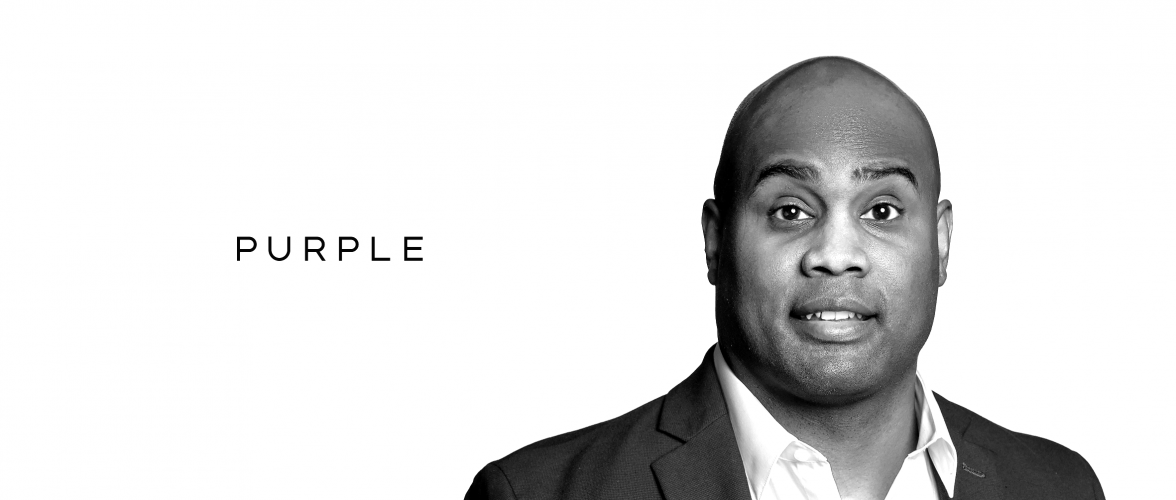
Posted on
September 29, 2021
2 Min. Read
Author
Purple Strategies
Purple Elevates Darryl Packard to General Counsel
Purple Strategies has appointed Darryl Packard as General Counsel at the firm. Darryl steps into the role with more than 15 years of experience in all aspects of business law, including from previous roles in the education, student loan and insurance industries. He joined Purple in 2019 and has become indispensable in all matters legal and regulatory, from contracts to compliance and legal strategy to litigation.
“Darryl started with us in 2019 as a lawyer but from the beginning, he’s been so much more,” said Steve McMahon, Purple co-founder and CEO. “He’s contributed enormously as our firm and our team have grown, and he’s provided consistently sound counsel to our partnership. We’re delighted to promote him to General Counsel and add him our leadership team, where he will continue to help us to chart the continued growth of Purple.”
In this new role, Darryl will advise on matters related to the future direction of the company. He will be able to provide insight on new and existing laws and legal rights that impact functionality of the business, including areas such as returning to the physical office, partnerships with vendors and contractors, and corporate governance matters. As Purple continues to evolve as a firm, Darryl will work as part of the senior leadership team to develop and expand policies, practices and processes to ensure sustainable growth.
Darryl received his bachelor’s degree from the Grambling State University College of Business and his Juris Doctor degree from the University of Massachusetts-Dartmouth. He is also a member of both the Virginia and Massachusetts State Bars.
“I enjoy being able to work in an environment with such a strong diversity of opinions and ideas, which is what we have at Purple,” says Darryl. “No day is the same, all thoughts are useful, and the confluence of diverse opinions makes this place special not only to me but to the benefit of our clients.”
 AI and Paradigm Shifts on the Minds of Healthcare CEOs
AI and Paradigm Shifts on the Minds of Healthcare CEOs  Purple Strategies Elevates Three To Partnership Group
Purple Strategies Elevates Three To Partnership Group